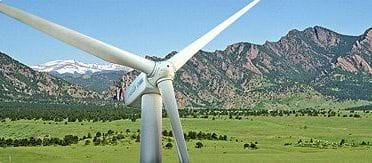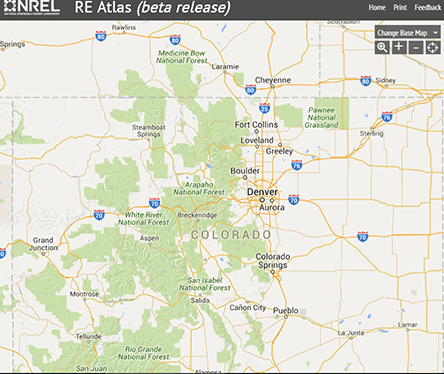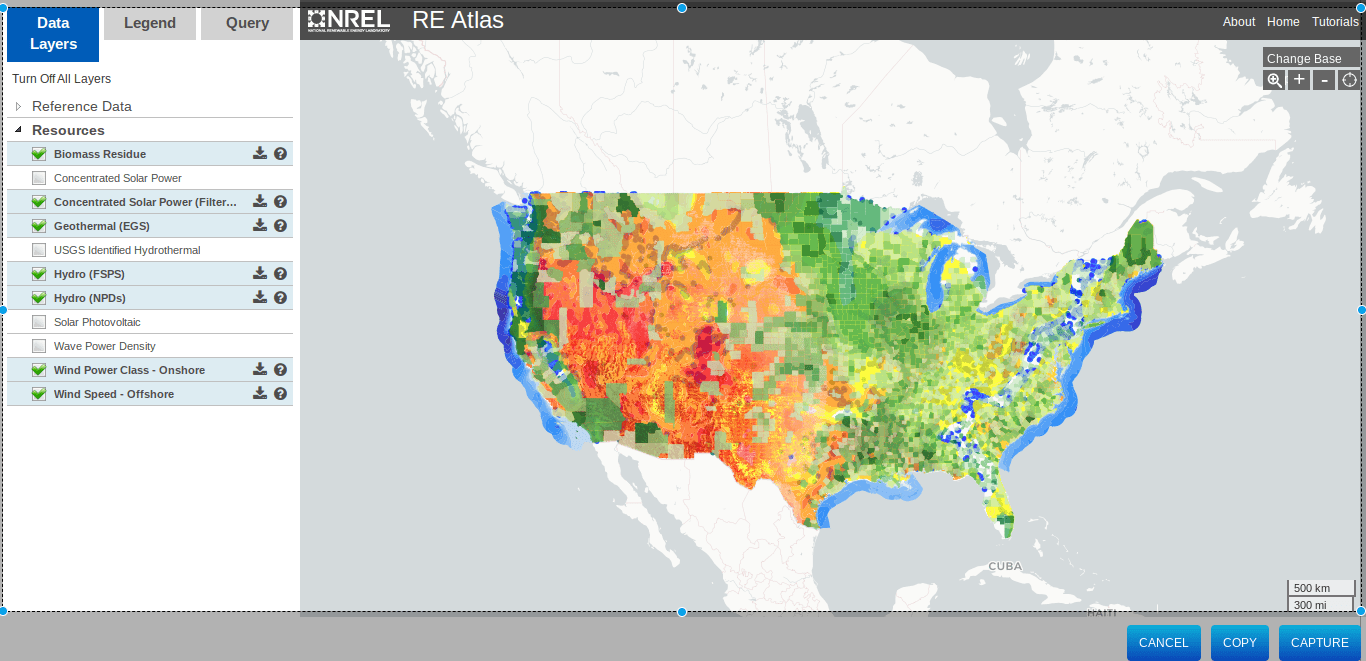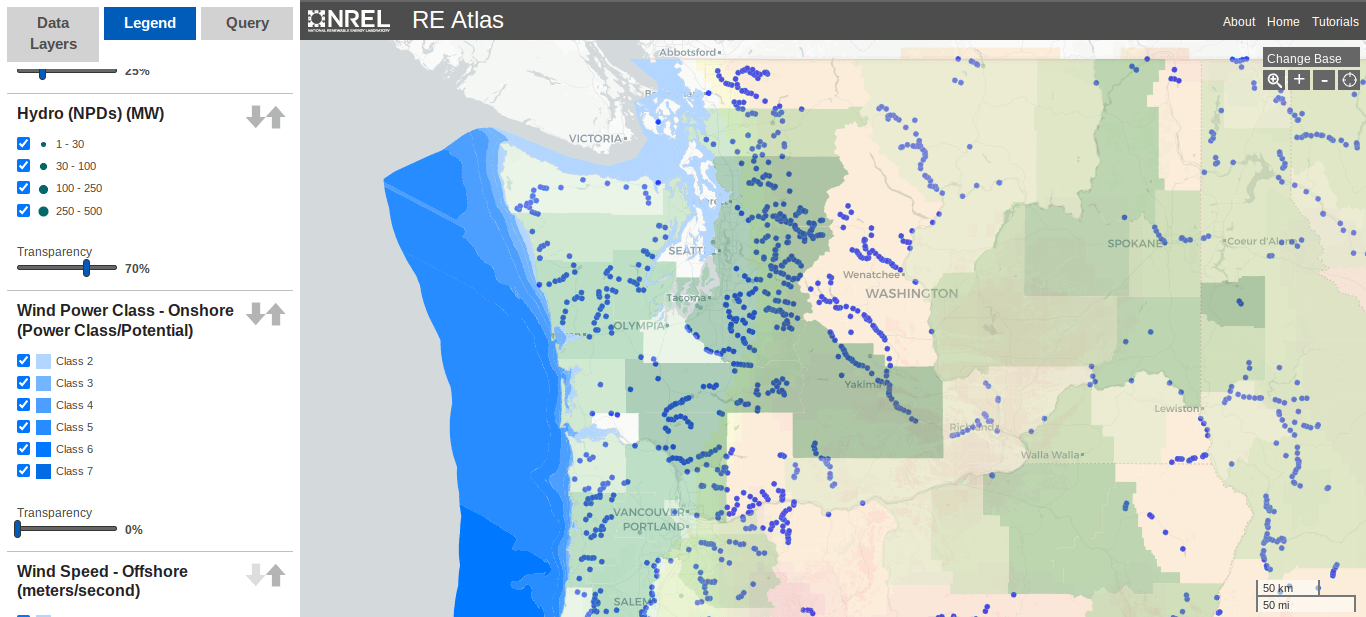Quick Look
Grade Level: 6 (5-8)
Time Required: 1 hours 30 minutes
(can be split into two 45-minute sessions)
Expendable Cost/Group: US $0.00
Group Size: 2
Activity Dependency: None
Subject Areas: Data Analysis and Probability, Physical Science, Science and Technology
NGSS Performance Expectations:

| MS-ETS1-1 |

Summary
Students use real-world data to evaluate various renewable energy sources and the feasibility of implementing these sources. Working in small groups, students use data from the Renewable Energy Living Lab to describe and understand the way the world works. The data is obtained through observation and experimentation. Using the living lab gives students and teachers the opportunity to practice analyzing data to solve problems or answer questions, in much the same way that scientists and engineers do every day.Engineering Connection
Engineers use data to understand problems and evaluate potential solutions. When designing systems to produce or transmit sustainable energy, or power, engineers look at opportunities to harness renewable resources such as wind, sunlight, biofuels (plant materials), geothermal heat and flowing water (dams, currents, tides), which are naturally replenished.
Engineers use both renewable and non-renewable energy sources to generate electricity, power vehicles, and make buildings functional. Renewable sources of energy vary widely in their cost-effectiveness and in their availability. Although water, wind and other renewables may seem free, the cost comes in collecting the energy, transporting it to the where it is needed, and storing it for later use. For example, to utilize energy from water, engineers must design and build dams along with electric generators and transmission lines. The Renewable Energy Living Lab gives students a chance to access the same data that is used by scientists and engineers to evaluate U.S. renewable energy sources.
Learning Objectives
After this activity, students should be able to:
- Identify five types of renewable energy.
- Use the Renewable Energy Living Lab to collect data on various energy forms.
- Analyze data to make recommendations for where renewable energy projects are best located.
- Identify the factors contributing to renewable energy feasibility.
Educational Standards
Each TeachEngineering lesson or activity is correlated to one or more K-12 science,
technology, engineering or math (STEM) educational standards.
All 100,000+ K-12 STEM standards covered in TeachEngineering are collected, maintained and packaged by the Achievement Standards Network (ASN),
a project of D2L (www.achievementstandards.org).
In the ASN, standards are hierarchically structured: first by source; e.g., by state; within source by type; e.g., science or mathematics;
within type by subtype, then by grade, etc.
Each TeachEngineering lesson or activity is correlated to one or more K-12 science, technology, engineering or math (STEM) educational standards.
All 100,000+ K-12 STEM standards covered in TeachEngineering are collected, maintained and packaged by the Achievement Standards Network (ASN), a project of D2L (www.achievementstandards.org).
In the ASN, standards are hierarchically structured: first by source; e.g., by state; within source by type; e.g., science or mathematics; within type by subtype, then by grade, etc.
NGSS: Next Generation Science Standards - Science
| NGSS Performance Expectation | ||
|---|---|---|
|
MS-ETS1-1. Define the criteria and constraints of a design problem with sufficient precision to ensure a successful solution, taking into account relevant scientific principles and potential impacts on people and the natural environment that may limit possible solutions. (Grades 6 - 8) Do you agree with this alignment? |
||
| Click to view other curriculum aligned to this Performance Expectation | ||
| This activity focuses on the following Three Dimensional Learning aspects of NGSS: | ||
| Science & Engineering Practices | Disciplinary Core Ideas | Crosscutting Concepts |
| Define a design problem that can be solved through the development of an object, tool, process or system and includes multiple criteria and constraints, including scientific knowledge that may limit possible solutions. Alignment agreement: | The more precisely a design task's criteria and constraints can be defined, the more likely it is that the designed solution will be successful. Specification of constraints includes consideration of scientific principles and other relevant knowledge that is likely to limit possible solutions. Alignment agreement: | All human activity draws on natural resources and has both short and long-term consequences, positive as well as negative, for the health of people and the natural environment. Alignment agreement: The uses of technologies and any limitations on their use are driven by individual or societal needs, desires, and values; by the findings of scientific research; and by differences in such factors as climate, natural resources, and economic conditions.Alignment agreement: |
International Technology and Engineering Educators Association - Technology
-
Apply the technology and engineering design process.
(Grades
3 -
5)
More Details
Do you agree with this alignment?
-
The management of waste produced by technological systems is an important societal issue.
(Grades
6 -
8)
More Details
Do you agree with this alignment?
-
Requirements for design are made up of criteria and constraints.
(Grades
6 -
8)
More Details
Do you agree with this alignment?
-
Analyze how the creation and use of technologies consumes renewable and non-renewable resources and creates waste.
(Grades
6 -
8)
More Details
Do you agree with this alignment?
-
Analyze examples of technologies that have changed the way people think, interact, and communicate.
(Grades
6 -
8)
More Details
Do you agree with this alignment?
-
Analyze how an invention or innovation was influenced by its historical context.
(Grades
6 -
8)
More Details
Do you agree with this alignment?
-
Create solutions to problems by identifying and applying human factors in design.
(Grades
6 -
8)
More Details
Do you agree with this alignment?
-
Energy can be grouped into major forms: thermal, radiant, electrical, mechanical, chemical, nuclear, and others.
(Grades
9 -
12)
More Details
Do you agree with this alignment?
-
Energy resources can be renewable or nonrenewable.
(Grades
9 -
12)
More Details
Do you agree with this alignment?
State Standards
Colorado - Science
-
Earth's natural resources provide the foundation for human society's physical needs. Many natural resources are nonrenewable on human timescales, while others can be renewed or recycled
(Grade
6)
More Details
Do you agree with this alignment?
Materials List
Each group needs:
- computer with internet access (or printed or projected renewable energy potential maps as found on the Renewable Energy Living Lab website)
- Energy Experts Worksheet, one per student
Worksheets and Attachments
Visit [www.teachengineering.org/activities/view/csm_energy_experts_activity1] to print or download.Pre-Req Knowledge
A basic understanding of map reading and ability to navigate the internet.
Introduction/Motivation
Renewable energy is a hot topic in science today. Many people assume that renewable or "green" energy sources are always the best solution. Today we will explore five types of renewable energy resources and determine where in the U.S. are the best locations to convert these resources into electrical energy.
Why do we need to generate electrical energy? We need electrical energy to power our industries, to move from place to place, to grow and cook our food, and to warm or cool our homes.
Currently, most electrical energy is generated by burning fossil fuels, which has significant negative impact on our environment. One potential solution to this is to use renewable energy sources instead.
What is renewable energy? Renewable energy is generated by resource that do not dwindle because of use or overuse. But are all renewable energy resources feasible solutions to generate electrical energy everywhere across the US? This is the question that we will investigate today.
To consider whether a renewable energy source is feasible, what questions would you ask? Here are a few examples:
- How does it work?
- How much is there/how much power potential?
- How much does it cost?
- What is the environmental impact?
- Is the resource available in the area where we need it?
We will learn more about renewable energy potential sources using the Renewable Energy Living Lab in the next few class periods. We will look at real-world data acquired from the Department of Energy National Laboratories.
Procedure
- Provide students with background for the activity: Today you will explore five forms of renewable energy and determine where in the U.S. are the best locations to use this energy. However, you must work within some constraints, as in real life. To solve this problem, we'll use real-world data hosted on a website called "a living lab."
- Pair students to work together. Small groups work best so each student has a chance to explore the data. Give each group an Energy Experts Worksheet as an activity guide.
- Navigate students to the Renewable Energy Living Lab:
Go to http://www.teachengineering.org/livinglabs/renewable_energy/ and click to enter the Renewable Energy Living Lab.
Review the five energy icons, and discuss why each is appropriate for its energy type. As an introduction to renewable energy, review the descriptive paragraphs about each energy source on the page. Visit the "How It Works" link to explore the engineering involved. 
- Choose age group K-12.

Navigation buttons to access K-12 data, or teacher resources. - Zoom in on your state.

Zoom and pan tools. - Check the boxes under the Resources folder (located on the left under the Data Layers tab) to switch between the maps depicting the potential for the five different forms of renewable hydropower, biomass, geothermal, wind and solar. Use the icons in the lower left corner to read more information about each form of energy.

Resources folder to check the boxes for the different forms of energy.
- Give students time to explore the living lab before they begin to analyze data. Point out the legend under the Legend tab. Point out the various units and color keys. Point out hot links at the bottom of the legend box for additional resources about each energy type.

Renewable Energy Living Lab screen shot showing legend. - Review the worksheet with the class by reading it aloud. Before they dive into the data, ask students to think about what types of information they will need in order to solve this problem. Direct students to discuss their ideas with their partners.
- Direct students to study the maps to find areas with high potential to develop solar, geothermal, wind, hydro and biomass energy. Note: Wind speed (m/s) is given on the map as opposed to wind power density. In order to obtain the power density (W/m2), students should use Table 1-1 Classes of Wind Power Density to determine the wind power density in W/m2 based off the wind speed (m/s) that they find on the map. This table is also given under the Wind Speed Offshore icon in the lower left corner. Students should use the column on the right to determine the wind power density at 50 m. It is not necessary for this activity to obtain the power density, however if students wish to use that for their analysis in addition to the wind speed, they may do so.
- Guide students to review the engineering criteria as they go through the worksheet exercise. These include:
- Sites must have a high potential for generating electrical energy from a renewable source.
- Sites should be within a reasonable driving distance, 200 miles, of an international airport.
- No more than two sites may be located within the same state.
- Identify three sites for each renewable energy plant: solar energy, geothermal energy, wind energy, hydropower and biomass energy.
- After the worksheet is completed, come together as a class to present solutions and discuss.
Vocabulary/Definitions
biomass: Biological (organic) material from living or dead organisms (especially plants) used as an energy source. Biomass used for electricity generation varies widely by region. Examples: Forest and wild plant growth (trees, branches, stumps), industrial wastes (such as from lumber and paper mills), urban waste (park trimmings, yard clippings, municipal solid waste, animal matter, sewage, food scraps), agricultural residues and fuel crops (corn, sugarcane, bamboo, hemp, wheat, straw, rice husks, grasses, algae, seaweed, animal fats, vegetable oils), etc.
fossil fuel: A type of fuel formed by the decay and decomposition process of dead organisms buried in the Earth for millions of years. Examples: Petroleum, natural gas, coal.
geothermal energy: Thermal (heat) energy from heat present under the Earth's surface.
hydropower: Power created from the movement (falling) of water. Dams are often used to create hydropower that can be converted to electricity.
renewable energy: Energy obtained from natural resources that are continually replenished, for example, regardless of how much of the Sun's heat energy is "used" today, more is received by the Earth tomorrow. Examples: Sunlight (solar energy), water (hydropower), geothermal, biomass.
wind turbine: A device similar to a windmill that moves with the wind to convert the kinetic energy created by the wind to mechanical energy. This mechanical energy can be converted to electrical energy as well.
Assessment
Pre-Activity Assessment
Energy Experts Engage: After students complete the ENGAGE section on the Energy Experts Worksheet, a written brainstorming opportunity, have them share with a partner so all voices are heard in the room. Then lead a class discussion to review possible answers and ideas for the prompts.
Activity Embedded Assessment
Energy Experts, Explore and Explain: While students access data and evaluate maps, verify understanding through questioning and monitoring of student work. As students navigate the website, walk around to observe their data. Ask them about units of measure and geographic trends.
Worksheet: As students explore the website, have them complete the data table and questions on the worksheet. Review their answers to gauge their understanding of the data.
Post-Activity Assessment
Energy Experts Elaborate and Evaluate: After students complete the ELABORATE questions on the worksheet, have them share their answers with the class. Point out similarities and differences within their solutions/difficulties.
As part of the EVALUATE portion of the worksheet, pair up partner groups to make groups of four students each. Provide each pair of partners with an opportunity to present their solutions to another group. Then, give students time to process what they learned by sharing solutions. Lead a class discussion to have students compare results. Alternately, have students present their solutions to the entire class and then complete the analysis questions.
Activity Scaling
- For upper grades, have students explore the other resources as well as utilize different reference data.
Additional Multimedia Support
Teacher resources: http://www.teachengineering.org/livinglabs/renewable_energy/educators.php
Subscribe
Get the inside scoop on all things TeachEngineering such as new site features, curriculum updates, video releases, and more by signing up for our newsletter!More Curriculum Like This

Students become familiar with the online Renewable Energy Living Lab interface and access its real-world solar energy data to evaluate the potential for solar generation in various U.S. locations. Through this activity, students and teachers gain familiarity with the living lab's GIS graphic interfa...

Students learn and discuss the advantages and disadvantages of renewable and non-renewable energy sources. They also learn about our nation's electric power grid and what it means for a residential home to be "off the grid."

Students use real-world data to evaluate whether solar power is a viable energy alternative for several cities in different parts of the U.S. Working in small groups, they examine maps and make calculations using NREL/US DOE data from the online Renewable Energy Living Lab.

Students use real-world data to calculate the potential for solar and wind energy generation at their school location. After examining maps and analyzing data from the online Renewable Energy Living Lab, they write recommendations as to the optimal form of renewable energy the school should pursue.
Other Related Information
This activity is designed around the Renewable Energy Living Lab, a resource of current and real-world scientific data, in this case a culmination of available renewable energy data from across the U.S. The data is available in a database with a graphical interface using a scaling map for viewing of regions as large as the continental U.S. and as small as a town. It is rare that students have access to query such as extensive body of scientific data to support their own inquiry-based questions. Additional background information is provided in the living lab interface including source information used to compile the data.
Copyright
© 2013 by Regents of the University of Colorado; original © 2012 Colorado School of MinesContributors
Mike Mooney; Minal Parekh; Jessica Noffsinger; Karen Johnson; Jonathan KnudtsenSupporting Program
Civil and Environmental Engineering Department, Colorado School of MinesAcknowledgements
This curriculum was created with the support of National Science Foundation grant no. DUE 0532684. However, these contents do not necessarily represent the policies of the National Science Foundation, and you should not assume endorsement by the federal government.
Last modified: February 1, 2022










User Comments & Tips